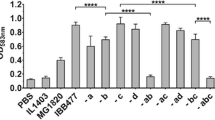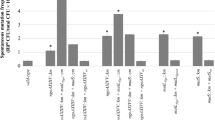Abstract
Base excision repair (BER) is dedicated to the repair of oxidative DNA damage caused by reactive oxygen species generated by chemical and physical agents or by metabolism which can react with DNA and cause a variety of mutations. Epithelial cells are typically the first type of host cell to come into contact with potential microbial invaders. In this work, we have evaluated whether the adherence to human epithelial cells causes DNA damage and associated filamentation. Experiments concerning adherence to HEp-2 cells were carried out with mutants deficient in BER that were derived from Escherichia coli K-12. Since the removal of mannose during bacterial interaction with HEp-2 cells allows adhesion through mannose-sensitive adhesins, the experiments were also performed in the presence and the absence of mannose. Our results showed enhanced filamentation for the single xth (BW9091) and triple xth nfo nth (BW535) mutants in adherence assays with HEp-2 cells performed without d-mannose. The increased filamentation growth was inhibited by complementation of BER mutants with a wild type xth gene. Moreover, we measured SOS induction of bacteria adhered to HEp-2 cells in the presence and absence of d-mannose through of SOS-chromotest assay and we observed a higher β-galactosidase expression in the absence of mannose. In this context, data showed evidence that bacterial attachment to HEp-2 epithelial surfaces can generate DNA lesions and SOS induction.





Similar content being viewed by others
References
Asad LMBO, Asad NR, Silva AB, Almeida CEB, Leitão AC (1997) Role of SOS and OxyR systems in the repair of Escherichia coli submitted to hydrogen peroxide under low iron conditions. Biochimie 79:359–364
Cordell SC, Robinson EJ, Love J (2003) Crystal structure of the SOS cell division inhibitor SulA and in complex with FtsZ. Proc Natl Acad Sci USA 100:7889–7894
Cravioto A, Gross RJ, Scotland SM, Rowe B (1979) An adhesive factor found in strains of Escherichia coli belonging to the traditional infantile enteropathogenic serotypes. Curr Microbiol 3:95–99
Dong T, Chiang SM, Joyce C, Yu R, Schellhorn HE (2009) Polymorphism and selection of rpoS in pathogenic Escherichia coli. BMC Microbiol 9:118
Eisen JA, Hanawalt PC (1999) A phylogenomic study of DNA repair genes, proteins, and processes. Mutat Res 435:171–213
Friedberg EC, Walker GC, Siede W, Wood RD, Schultz RA, Ellenberger T (2006) DNA repair and mutagenesis 2nd edn. ASM Press, Washinton DC
Gotoh H, Kasaraneni N, Devineni N, Dallo SF, Weitao T (2010) SOS involvement in stress-inducible biofilm formation. Biofouling 26:603–611
Janion C, Sikora A, Nowosielska A, Grzesiuk E (2003) E. coli BW535, a triple mutant for the DNA repair genes xthA, nth, nfo, chronically induces the SOS response. Environ Mol Mutagen 41:237–242
Justice SS, Julie CH, Daniel AT, Gregory AF, Matthew GA, Footer J, Hultgren SJ (2004) Differentiation and developmental pathways of uropathogenic Escherichia coli in urinary tract pathogenesis. Proc Natl Acad Sci USA 101(5):1333–1338
Justice SS, Hunstad DA, Seed PC, Hultgreen SJ (2006) Filamentation by Escherichia coli subverts innate defenses during urinary tract infection. Proc Natl Acad Sci USA 103:19884–19889
Justice SS, Hunstad DA, Cegelski L, Hultgreen SJ (2008) Morphological plasticity as a bacterial survival strategy. Nature 6:162–168
Merino D, Reglier-Poupet H, Berche P, Charbit A (2002) A hypermutator phenotype attenuates the virulence of Listeria monocytogenes. Mol Microbiol 44:877–887
Mysorekar IU, Mulvey MA, Hultgren SJ, Gordon JI (2002) Molecular regulation of urothelial renewal and host defenses during infection with uropathogenic Escherichia coli. J Biol Chem 277:7412–7419
Nataro JP, Deng Y, Maneval DR, German AL, Martin WC, Levine MM (1992) Aggregative adherence Fimbriae I of enteroaggregative Escherichia coli mediate adherence to HEp-2 cells and hemagglutination of human erythrocytes. Infect Immun 60(6):2297–2304
O’Rourke EJ, Chevalier C, Pinto AV, Thiberge JM, Ielpi L et al (2003) Pathogen DNA as target for host-generated oxidative stress: role for repair of DNA damage in Helicobacter pylori colonization. Proc Natl Acad Sci USA 100:2789–2794
Okeke IN, Macfarlane-Smith LR, Fletcher JN, Snelling AM (2011) IS3 profiling identifies the enterohaemorrhagic Escherichia coli O-island 62 in a distinct enteroaggregative E. coli lineage. Gut Pathog 3:4
Otterlei M, Kavli B, Standal R, Skjelbred C, Bharati S, Krokan HE (2000) Repair of chromosomal abasic sites in vivo involves at least three different repair pathways. EMBO J 19:5542–5551
Prieto AI, Ramos-Morales F, Casadesús J (2006) Repair of DNA damage induced by bile salts in Salmonella enterica. Genetics 174:575–584
Quillardet P, Hofnung M (1985) The SOS chromotest, a colorimetric bacterial assay for genotoxicity procedures. Mutat Res 147:65–78
Roblin PM, Dumornay W, Hammerschlag MR (1992) Use of HEp-2 cells for improved isolation and passage of Chlamydia pneumoniae. J Clin Microbiol 30(8):1968–1971
Rosa ACP, Mariano AT, Pereira AMS, Tibana A, Gomes TAT, Andrade JRA (1998) Enteropathogenicity markers in Escherichia coli isolated from infants with acute diarrhea and healthy controls in Rio de Janeiro, Brazil. J Med Microbiol 47:781–790
Rosenberger CM, Finlay BB (2002) Macrophages inhibit Salmonella typhimurium replication through MEK/ERK kinase and phagocyte NADPH oxidase activities. J Biol Chem 277:18753–18762
Sambrook J, Russell DW (2001) Molecular cloning: a laboratory manual. Cold Spring Harbor Laboratory Press, London
Schapiro JM, Libby SJ, Fang FC (2003) Inhibition of bacterial DNA replication by zinc mobilization during nitrosative stress. Proc Natl Acad Sci USA 100:8496–8501
Suvarnapunya AE, Lagasse HA, Stein MA (2003) The role of DNA base excision repair in the pathogenesis of Salmonella enterica serovar Typhimurium. Mol Microbiol 48:549–559
Ulett GC, Webb RI, Schembri MA (2006) Antigen-43 mediated autoaggregation impairs motility in Escherichia coli. Microbiology 152:2101–2110
van der Veen S, Abee T (2010) Dependence of continuous-flow biofilm formation by Listeria monocytogenes EGD-e on SOS response factor YneA. Appl Environ Microbiol 76:1992–1995
Walker GC (1985) Inducible DNA repair systems. Annu Rev Biochem 54:425–457
Wallace SS (1997) Oxidative damage to DNA and its repair. In: Scandalios JG (ed) Oxidative stress and the molecular biology of antioxidant defenses. Cold Spring Harbor Laboratory, Cold Spring Harbor, pp 49–90
Xianhua Y, Feng Y, Wheatcroft R, Chambers J, Gong J, Gyles CL (2011) Adherence of Escherichia coli O157: H7 to epithelial cells in vitro and in pig gut loops is affected by bacterial culture conditions. Can J Vet Res 75(2):81–88
Acknowledgments
This work was supported by grant from FAPERJ, CNPq, CAPES, SR-2/UERJ and Programa de Núcleo de Excelência (PRONEX) of the Brazilian Ministry of Science and Technology. We thank Bernard Weiss for generously providing the bacterial strains and plasmids. We are also grateful to Maria Angélica Pereira da Silva and Wagner Oliveira Brito for technical assistance.
Author information
Authors and Affiliations
Corresponding author
Rights and permissions
About this article
Cite this article
Costa, S.B., Campos, A.C.C., Pereira, A.C.M. et al. The role of DNA base excision repair in filamentation in Escherichia coli K-12 adhered to epithelial HEp-2 cells. Antonie van Leeuwenhoek 101, 423–431 (2012). https://doi.org/10.1007/s10482-011-9649-z
Received:
Accepted:
Published:
Issue Date:
DOI: https://doi.org/10.1007/s10482-011-9649-z




